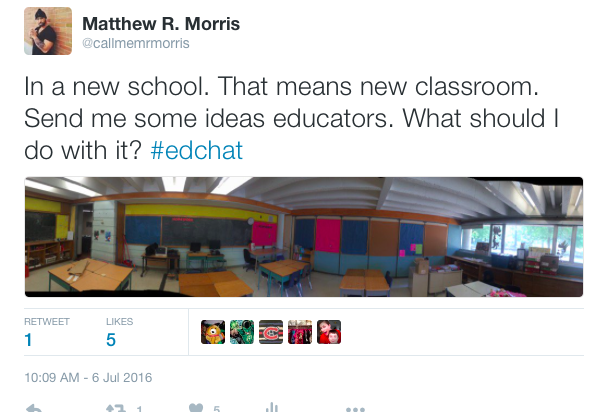A few years ago, I took an AQ (additional qualifications) course and one of the first assignments was creating a visual representation of my ideal classroom. I basically had to draw a picture of what my “perfect classroom” looked like. Of course, a detailed explanation of the classroom set-up was required as well. The rationale had to demonstrate your ability to link pedagogy with practice. For example, if you chose to group desks you had to explain why. So, I began sketching out what my ideal classroom would look like. I closed my eyes and imagined exactly what it would look like if I were creating a classroom from scratch. I penciled it out and handed it in, complete with rationale. Assignment finished, AQ was eventually received, back to teaching in room 207 – with nothing changed.
This upcoming fall, I will inevitably have to make some changes to my classroom. The last three years I’ve had the luxury of heading into summer break thinking little about classroom set up. I’ve been in the room for a while and things flow comfortably. We’ve got a couch in there, a nice classroom library, and of course, no teacher’s desk anywhere to be found. But since I am moving schools, I am going to have to put some thought into how I want my classroom to be set up.
Naturally, I posed the question on my Twitter and asked educators to chime in with thoughts on how I ought to create this new classroom. I received some noteworthy replies that aligned with my conservative AQ activity. Get rid of desks, change the color to stimulate more concentration, have a group work area and so on. Then I got a reply that seemed so simple yet so deeply entrenched in “pedagogy” that I couldn’t believe I hadn’t thought of it earlier. It was, “wait until the first week of school and let your students help design the place”. Duh? Of course.
When it comes to schooling, teachers are always talking about co-creating with students and merely becoming the “lead learner” in the classroom. But how often do we live this? Students walk into class at the beginning of the year and immediately yield to the unequal power balance (I am not saying that the balance of power in the classroom should be an equal ratio, I am just saying teachers don’t need to be worried about negotiating a little). They walk in and see a freshly decorated classroom, sometimes get told where to sit, and always get fed a bevy of first week activities. All of this translating to a top-down approach to learning.
Student agency in their own learning. A motto I want to instill next year. And what better way to head down this path than by allowing students ownership in their classroom by creating their ideal learning space. I know most teachers are type A personalities and want everything prepared in advance, especially when it comes to that first week and especially when it comes to their classroom. And perhaps the ease of already having a classroom decorated dulls the willingness to try something like this. But, when you are not hinged to those two things, why not go for it? With some structure of course, the classroom will become a true reflection of their ideals, skills, and standards. That sounds pretty inspiring to me. And to think, despite handing in a piece of paper of my ideal classroom a few years back, I hadn’t thought about how I could actually do this in reality. Thankfully, a new classroom is awaiting me in September.
[share title=”Share this Post” facebook=”true” twitter=”true” google_plus=”true”]

